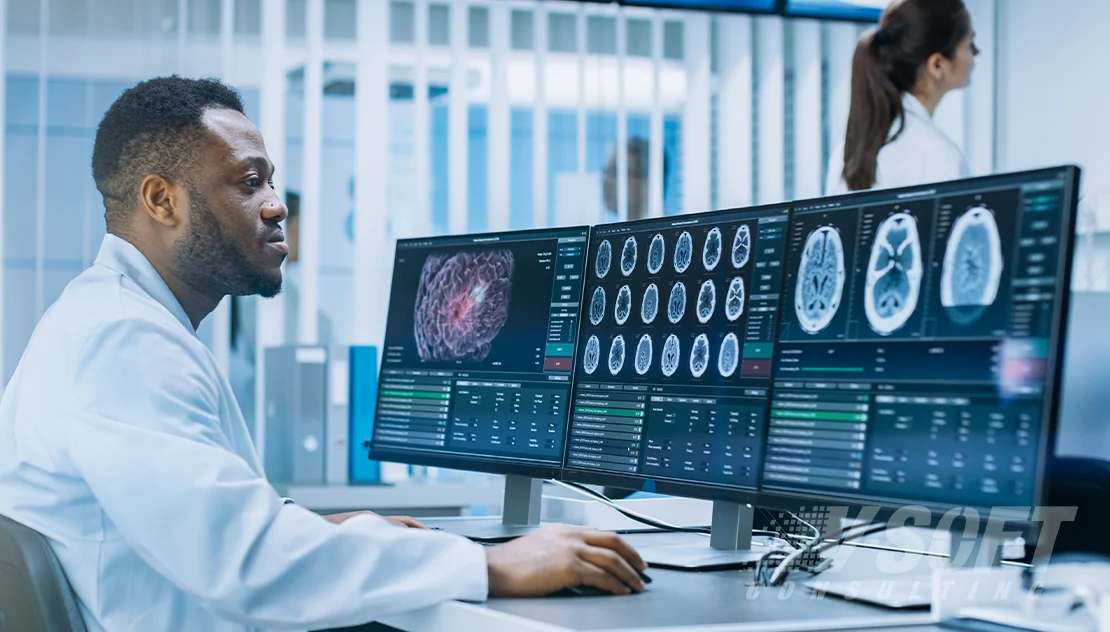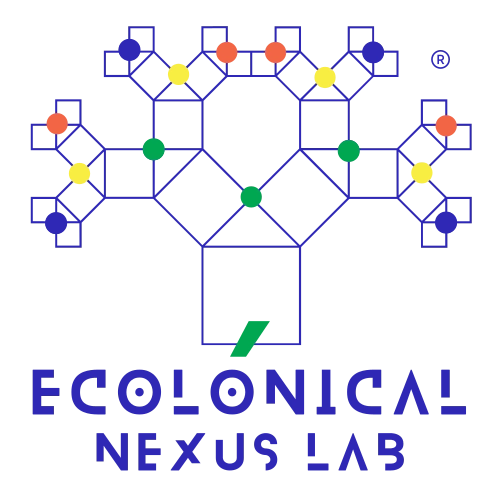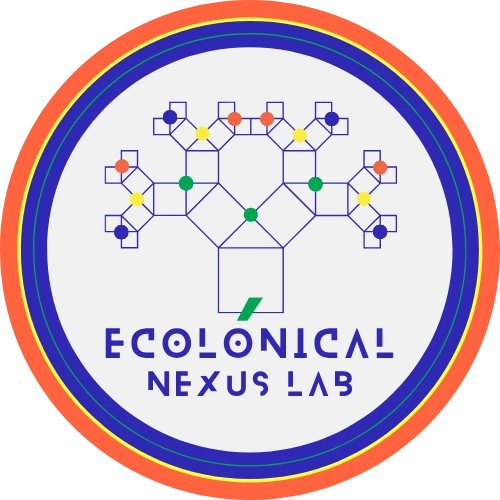No products in the cart.

AI in Healthcare: Transformative Innovations, Trends, and Ethical Considerations (2014-2023)
Contents
- I. Abstract
- II. Introduction
- III. Literature Review
- IV. Methodology
- V. Results
- A. Machine Learning Algorithms for Disease Diagnosis and Prognosis
- B. Predictive Analytics in Personalized Medicine and Treatment Optimization
- C. Natural Language Processing for Clinical Text Mining and Data Extraction
- D. Computer Vision Techniques for Medical Image Analysis and Interpretation
- E. Data Privacy and Security Considerations in Healthcare AI Applications
- F. Case Studies on the Use of AI in Cancer Detection
- VI. Future Directions
- A. Future Research Directions in Machine Learning Algorithms for Disease Diagnosis and Prognosis
- B. Future Research Directions in Predictive Analytics in Personalized Medicine and Treatment Optimization
- C. Future Research Directions in Natural Language Processing for Clinical Text Mining and Data Extraction
- D. Future Research Directions in Computer Vision Techniques for Medical Image Analysis and Interpretation
- E. Future Research Directions in Data Privacy and Security Considerations in Healthcare AI Applications
- VII. Conclusions
- REFERENCES
- Further Reading: Resources on AI and Healthcare
- FAQ: Common Questions About AI in Healthcare
- How is AI transforming disease diagnosis and prognosis in healthcare?
- What ethical considerations should be addressed when deploying AI in healthcare?
- Is AI truly ready to replace human doctors in diagnosing and treating patients?
- How can we ensure AI systems do not perpetuate or amplify biases in healthcare?
- Can we trust AI to make life-and-death decisions in critical healthcare settings?
- What happens when AI systems make errors in patient care? Who is responsible?
- Are we sacrificing patient privacy for the sake of AI in healthcare?
- Author
I. Abstract
The integration of Artificial Intelligence (AI) in healthcare has driven significant advancements, reshaping how medical professionals diagnose, treat, and manage diseases. This comprehensive review examines the evolution of AI in healthcare from 2014 to 2023, focusing on key innovations, emerging trends, and their transformative impact on healthcare delivery. The review explores AI applications across various medical domains, highlighting methodologies, challenges, and future opportunities shaping healthcare’s future.
AI in healthcare is transforming industries by improving diagnosis accuracy, enhancing treatment protocols, and enabling personalized medicine. This article offers insights into the evolving landscape of AI technologies, identifying both the opportunities and the challenges that healthcare professionals and policymakers face when integrating AI into clinical settings.
This review provides valuable knowledge for researchers, healthcare professionals, and policymakers committed to advancing the role of AI in improving global health outcomes.
“The article aims to serve as a valuable resource for individuals seeking to understand the use of AI in healthcare and its implications.”
II. Introduction
III. Literature Review
A. Applications of AI in Healthcare
The integration of AI in Healthcare has led to numerous groundbreaking applications that have enhanced various aspects of the healthcare industry. One prominent application is in clinical practice, where AI supports healthcare professionals in making more accurate diagnoses and treatment decisions. Machine learning algorithms are employed to analyze medical images, such as X-rays, MRIs, and CT scans, enabling automated detection and classification of diseases. This enhances early detection and improves patient outcomes.
AI also plays a crucial role in clinical decision support systems, offering recommendations based on patient data and medical knowledge to guide healthcare providers in selecting the most appropriate treatment options.
Personalized treatment planning is another area where AI in Healthcare is making substantial contributions. By leveraging patient data and historical treatment outcomes, AI algorithms can design personalized treatment plans tailored to individual patients, taking into account their unique characteristics and medical history. This leads to more targeted interventions, reducing the risk of adverse effects and improving the success rates of treatments.
Additionally, AI is transforming drug discovery and development by identifying potential drug candidates, predicting drug interactions and adverse reactions, and accelerating the overall discovery process.
In genomics research, AI in Healthcare is instrumental in analyzing vast genomic datasets, identifying genetic variations linked to diseases, predicting disease risks, and driving precision medicine. By understanding the genetic foundations of diseases, personalized treatment strategies can be devised, resulting in better patient outcomes and more efficient healthcare delivery.
AI-powered virtual assistants and chatbots are also becoming integral to healthcare settings. These systems engage with patients, offering real-time health monitoring, appointment scheduling, medication reminders, and general health guidance. Virtual assistants can provide patients with direct answers, while chatbots, powered by natural language processing (NLP), enable patients to communicate their symptoms and receive preliminary medical advice, triaging cases and directing patients to the appropriate healthcare resources. This improves patient engagement, accessibility, and convenience in healthcare delivery.
B. Methodologies and Algorithms
To fully harness the power of AI in Healthcare, researchers use a wide variety of methodologies and algorithms. Deep learning models, particularly convolutional neural networks (CNNs) and recurrent neural networks (RNNs), have shown exceptional performance in tasks such as medical image analysis. CNNs are adept at detecting patterns and features within medical images, which allows for the automated detection and segmentation of abnormalities. RNNs, on the other hand, excel at analyzing sequential data, making them ideal for applications such as time-series analysis and medical record processing.
In addition to deep learning, other machine learning techniques like support vector machines (SVMs), decision trees, and random forests are commonly used in clinical decision support systems. SVMs are particularly effective in classifying and predicting patient outcomes based on various features, while decision trees and random forests help with risk prediction and treatment decision-making by mapping out decision paths based on patient characteristics.
Natural language processing (NLP) plays a crucial role in extracting insights from unstructured clinical text data, such as electronic health records (EHRs) and medical literature. NLP algorithms help in extracting valuable information, such as symptoms, diagnoses, and treatment outcomes, from clinical narratives, thereby enabling data-driven healthcare decision-making. These algorithms also facilitate the development of clinical coding systems, which convert free-text clinical data into structured formats for analysis and research purposes.
C. Data Science and Statistics in Healthcare
Data science and statistical methods are essential in developing and evaluating AI in Healthcare systems. Data preprocessing techniques are crucial to ensure the quality and integrity of healthcare datasets. These techniques include data cleaning to eliminate noise and errors, feature selection to identify relevant variables, and dimensionality reduction to manage large and complex datasets. These steps are vital in preparing data for AI model training and analysis.
Statistical analysis is employed to interpret the outputs of AI models and assess their performance. Descriptive statistics provide insights into the distribution and characteristics of healthcare data, while inferential statistics help researchers draw conclusions and make predictions based on sample data. Techniques such as survival analysis are used to study time-to-event data, critical for analyzing disease progression and patient survival rates. Regression analysis aids in identifying relationships between variables, enabling predictive modeling, while hypothesis testing allows researchers to evaluate the significance of findings and draw statistically supported conclusions.
Beyond model evaluation, statistical analysis contributes to clinical research and outcome analysis. Researchers use statistical methods to assess treatment effectiveness, compare interventions, and identify factors influencing patient outcomes. Rigorous statistical analysis helps healthcare professionals make evidence-based decisions and optimize patient care strategies.
Furthermore, data science methodologies are used to extract actionable insights from healthcare data. Data mining techniques uncover patterns and relationships within large datasets, helping identify risk factors, treatment response predictors, and other critical healthcare insights. Data visualization also plays a key role in presenting complex healthcare information in a visually appealing and accessible format, aiding in data exploration, pattern recognition, and communication of findings to stakeholders.
IV. Methodology
The data for this study was collected from the Web of Science database on May 21, 2023. The following search query was used in the Web of Science Core Collection, yielding 971 results: “healthcare (Topic) and “artificial intelligence” (Topic) and 2023 or 2022 or 2021 or 2020 (Publication Years) and Review Article (Document Types) and Early Access or Book Chapters (Exclude – Document Types) and English (Languages)”.
V. Results
A. Machine Learning Algorithms for Disease Diagnosis and Prognosis
The use of machine learning algorithms in healthcare has advanced significantly, particularly in disease diagnosis and prognosis. These algorithms leverage large datasets, including medical images, electronic health records (EHRs), and genetic information, to identify patterns and predict outcomes. By applying machine learning, healthcare professionals can achieve more accurate diagnoses, detect complex disease patterns, and personalize treatment plans. For example, the study by Gulshan et al. (2016) focused on a deep learning algorithm for diagnosing chronic myeloid leukemia (CML). This algorithm uses patient data and medical images to accurately identify CML cases and predict prognosis, demonstrating the potential of AI in improving disease management.
B. Predictive Analytics in Personalized Medicine and Treatment Optimization
Predictive analytics is another important application of AI in healthcare, particularly in personalized medicine and treatment optimization. AI models analyze patient data, including genetic information, medical history, and lifestyle factors, to recommend personalized treatment plans. This approach has the potential to improve patient outcomes, reduce healthcare costs, and advance precision medicine. For instance, Li et al. (2019) developed a predictive model for breast cancer diagnosis and treatment using genetic data, patient history, and clinical information. This model highlights the potential of predictive analytics in optimizing treatment plans and improving patient outcomes in oncology.
C. Natural Language Processing for Clinical Text Mining and Data Extraction
Natural Language Processing (NLP) has become a key tool in healthcare AI, especially for analyzing unstructured clinical text data, such as EHRs and medical literature. NLP techniques extract meaningful information from clinical narratives, enabling healthcare professionals to make informed decisions, conduct research, and improve patient care. For example, Soysal et al. (2018) reviewed NLP techniques in clinical text mining, focusing on applications like information extraction from EHRs, clinical decision support, and detecting adverse drug events.
D. Computer Vision Techniques for Medical Image Analysis and Interpretation
Advances in computer vision techniques have revolutionized medical image analysis, allowing AI algorithms to detect abnormalities in X-rays, MRIs, and histopathology slides. These algorithms aid in early disease detection and improve diagnostic accuracy. The use of Convolutional Neural Networks (CNNs) for image classification, segmentation, and detection tasks has been particularly transformative. Litjens et al. (2017) reviewed CNN applications in medical imaging, showing their effectiveness in radiology, pathology, and ophthalmology.
E. Data Privacy and Security Considerations in Healthcare AI Applications
As AI technologies become more widespread in healthcare, ensuring data privacy and security is essential. This research area focuses on developing privacy-preserving algorithms and encryption techniques to protect patient data while still enabling AI-driven analysis. Wang et al. (2014) reviewed privacy-preserving data mining techniques, discussing methods like secure multi-party computation, homomorphic encryption, and anonymization to safeguard patient data while enabling analysis. Balancing data privacy with the utility of healthcare AI is critical for maintaining patient trust and ensuring compliance with regulations.
F. Case Studies on the Use of AI in Cancer Detection
Esteva et al. (2017) presented a case study that highlights the use of machine learning algorithms in cancer detection. By utilizing a large dataset of medical images, EHRs, and genomic data, the study developed a predictive model to diagnose cancer and predict patient outcomes. The models achieved high accuracy and were able to predict the progression of the disease, enabling healthcare professionals to create personalized treatment plans.
VI. Future Directions
Future research should focus on refining AI algorithms, enhancing interoperability, improving data sharing capabilities, and addressing both regulatory and ethical concerns. These advancements are essential for the widespread adoption of AI in healthcare, opening the door to personalized, data-driven healthcare practices.
A. Future Research Directions in Machine Learning Algorithms for Disease Diagnosis and Prognosis
While machine learning (ML) algorithms have made significant strides in disease diagnosis and prognosis, there are several areas for further exploration:
Integration of Multimodal Data
To improve diagnostic accuracy and prognostic capabilities, future research should focus on integrating diverse data sources, such as medical images, genetic information, and clinical measurements. This multimodal data approach will provide healthcare providers with a comprehensive understanding of patient health, enabling more precise predictions and tailored care.
Transfer Learning and Domain Adaptation
Given that healthcare systems and datasets differ across institutions, developing ML models capable of adapting to new datasets with minimal labeled data is vital. Research should investigate transfer learning techniques to apply models trained on one dataset to others, improving the flexibility and scalability of machine learning in various healthcare environments.
Real-Time and Point-of-Care Applications
Future research should focus on developing algorithms that can analyze and process healthcare data in real-time, facilitating point-of-care applications. Optimizing these algorithms for efficiency, scalability, and integration with portable devices is essential to support real-time decision-making in clinical settings.
B. Future Research Directions in Predictive Analytics in Personalized Medicine and Treatment Optimization
Predictive analytics has great potential in personalized medicine and treatment optimization. Future research should focus on the following areas:
Longitudinal and Dynamic Modeling
Research should explore methods that capture the dynamic nature of disease progression over time, utilizing time-series data from patient records, wearable devices, and continuous monitoring systems to create more accurate predictive models.
Integration of Multi-Omics Data
Integrating multi-omics data (including genomics, transcriptomics, proteomics, and metabolomics) into predictive models will deepen our understanding of disease mechanisms and enable more accurate, personalized treatment strategies.
Real-World Evidence and Outcome Evaluation
To validate predictive analytics, future research must emphasize the collection of real-world data through observational studies and clinical trials. This evidence will demonstrate the effectiveness of predictive models in clinical settings and help refine treatment strategies.
Clinical Decision Support Systems
Future research should focus on enhancing clinical decision support systems by integrating predictive analytics. This will allow healthcare providers to make data-driven decisions based on personalized predictions, improving the quality of patient care.
C. Future Research Directions in Natural Language Processing for Clinical Text Mining and Data Extraction
Natural language processing (NLP) continues to play a crucial role in AI-powered healthcare. Future research should explore the following areas:
Clinical Language Understanding
Developing NLP models that can accurately understand clinical language, including complex medical terms and context, is essential. Researchers should focus on creating domain-specific models and ontologies to improve the precision of clinical text mining.
Clinical Phenotyping and Cohort Identification
NLP techniques should be refined to accurately identify and categorize patient cohorts based on clinical data, comorbidities, and treatment histories. This will support research, epidemiological studies, and precision medicine by enabling efficient cohort stratification.
Clinical Documentation Improvement
Exploring the use of NLP to automate clinical documentation tasks such as coding and summarization will reduce the documentation burden and improve the accuracy of clinical records, enabling more efficient workflows in healthcare.
D. Future Research Directions in Computer Vision Techniques for Medical Image Analysis and Interpretation
Computer vision has transformed medical image analysis. To further advance the field, future research should focus on:
Deep Learning Architectures
Future research should explore new deep learning architectures specifically designed for medical image analysis. These architectures should be capable of handling multi-modal imaging data, improving both performance and interpretability in clinical settings.
Explainability and Interpretability
Given the complexity of deep learning models, it is essential to prioritize research in explainability and interpretability. This will help build trust among healthcare professionals, allowing them to better understand how AI systems make decisions.
Multi-Modal Image Fusion and Analysis
Research should investigate techniques to effectively fuse multi-modal medical images (e.g., CT, MRI, PET scans) to improve diagnostic accuracy and provide more comprehensive insights into patient conditions.
E. Future Research Directions in Data Privacy and Security Considerations in Healthcare AI Applications
As AI technologies expand in healthcare, protecting patient data remains a critical concern. Future research should focus on:
Privacy-Preserving Machine Learning
Research should focus on developing privacy-preserving machine learning techniques, such as federated learning and differential privacy, which allow for secure, collaborative analysis without compromising patient confidentiality.
Adversarial Attacks and Defenses
With AI systems becoming more prevalent, protecting them from adversarial attacks is vital. Future research should focus on strengthening models against such threats to ensure the security of AI systems in healthcare applications.
Explainable AI for Privacy
Explainable AI is key to addressing privacy concerns. By making AI systems transparent, patients and healthcare professionals can better understand how decisions are made, building trust and ensuring privacy.
Ethical Frameworks and Governance
Future research should also focus on developing robust ethical frameworks and governance models for AI use in healthcare. This includes addressing issues related to consent, data ownership, algorithmic bias, and equitable healthcare access.
The future of healthcare AI lies in the integration of diverse data sources, improving real-time applications, and ensuring transparency and privacy. By advancing research in these areas, we can unlock AI’s full potential, leading to better patient outcomes, optimized treatments, and more personalized care.
VII. Conclusions
REFERENCES
Further Reading: Resources on AI and Healthcare
A curated selection of public resources and tools relevant to the application of AI in healthcare. These links are aligned with the themes discussed in the article.
Research Platforms & Tools
- AI & Healthcare Articles – In-depth resources and articles hosted on Ecolonical.org about AI applications, ethics, and healthcare innovation.
Community-Based Healthcare Science
- Global Health Alliance – A platform to track health initiatives and the integration of AI into global healthcare systems.
FAQ: Common Questions About AI in Healthcare
How is AI transforming disease diagnosis and prognosis in healthcare?
What ethical considerations should be addressed when deploying AI in healthcare?
Is AI truly ready to replace human doctors in diagnosing and treating patients?
How can we ensure AI systems do not perpetuate or amplify biases in healthcare?
Can we trust AI to make life-and-death decisions in critical healthcare settings?
What happens when AI systems make errors in patient care? Who is responsible?
Are we sacrificing patient privacy for the sake of AI in healthcare?
Author
-

Milena-Jael Silva-Morales is a systems engineer with a PhD in Urban and Territorial Systems and the founder of Ecolonical LAB, an independent research lab integrating data science, AI, and territorial systems to address local and global sustainability challenges. With over 15 years of experience leading international, multidisciplinary R&D initiatives, she is recognized for bridging science, technology, and policy to deliver transformative solutions in water, energy, and biodiversity systems.
View all posts
This article is governed by the Ecolonical Open Knowledge License (EOKL Lite V1). This license explicitly prohibits the use of its contents for AI model training, dataset integration, algorithmic processing, or automated decision-making systems. Unauthorized computational aggregation, reproduction beyond permitted terms, and any use conflicting with open knowledge principles are strictly restricted.
For legally binding terms, compliance obligations, and permitted exceptions, refer to the License Usage Policy.
Under specific conditions, this content aligns with the Creative Commons Attribution-NonCommercial-ShareAlike 4.0 International License. However, any AI-related processing, direct commercial exploitation, or automated derivative work remains subject to EOKL Lite V1 restrictions.
You May Also Like
5 Insights on Ethical AI and LLMs in Art: The Future of Creative Technology
Delve into this article to uncover the ethical considerations surrounding the use of Ethical AI and
AI for Biodiversity: Progress or Ethical Dilemma?
From data privacy to indigenous rights, explore whether AI is truly the solution or if it risks crea
Open Data or Closed Doors? 3 Powerful Insights on Who Controls Access and Sharing
Open data promises access for all, but hidden gatekeepers decide who benefits. Discover the ethics,







Leave a Reply